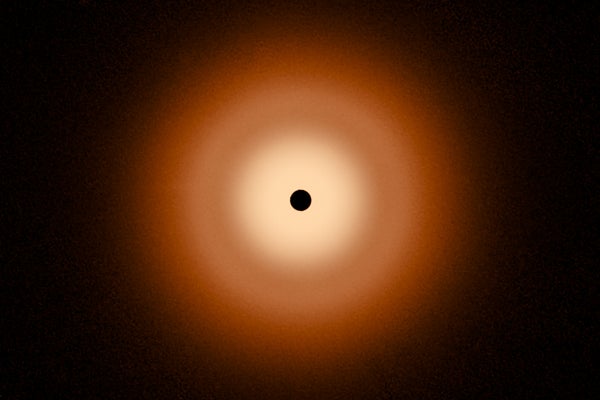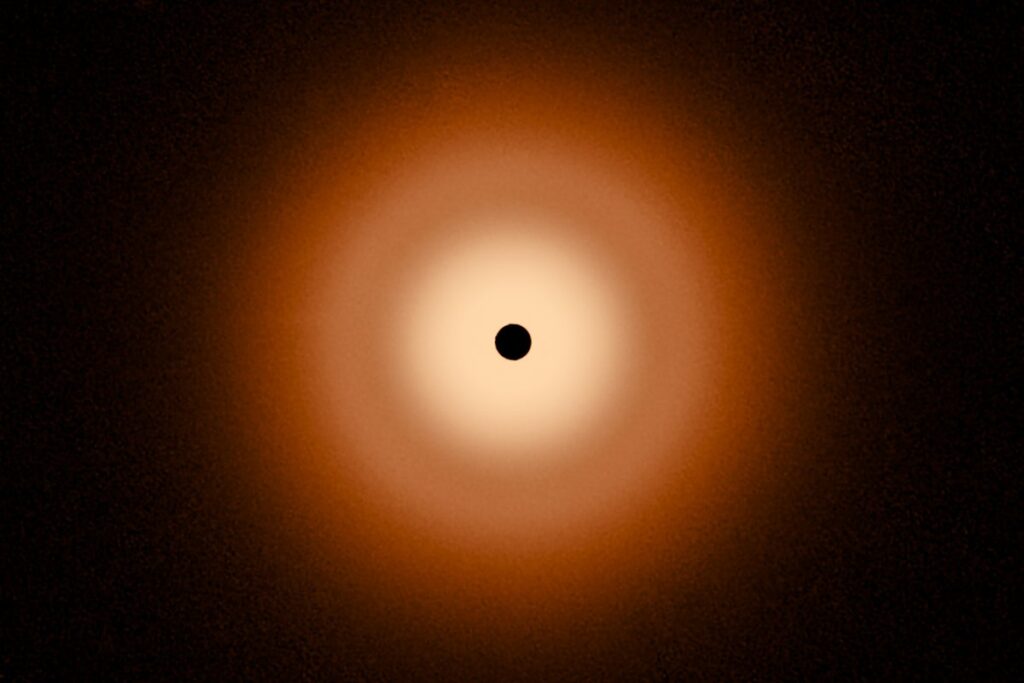[ad_1]
November 19, 2024
5 min read
Famous Star Hasn’t Formed Planets, and We Don’t Know Why
The nearby star Vega, featured in the 1997 movie Contact, appears to have a smooth disk devoid of giant planets for reasons we can’t explain

An image of the preternaturally smooth circumstellar disk around the bright nearby star Vega, acquired using the Mid-Infrared Instrument (MIRI) of NASA’s James Webb Space Telescope.
NASA, ESA, CSA, STScI, S. Wolff (University of Arizona), K. Su (University of Arizona), A. Gáspár (University of Arizona)
The nearby star Vega holds a special place in human culture. Located just 25 light-years away, this shining beacon—about twice the mass of the sun and 40 times as bright—is so prominent in Earth’s skies that it captivated ancient astronomers across the globe. A few thousand years ago it was also our planet’s North Star, until Polaris took its place as Earth’s axis wobbled. (Vega is set to reclaim the North Star crown in 12,000 years). As such, many have considered this iconic star an intriguing place to look for life, none more so than the astronomer Carl Sagan, who imagined signals from an intelligent civilization arriving from Vega in his 1985 novel Contact, which was adapted into a blockbuster movie in 1997.
So there was some disappointment earlier this month when astronomers announced a baffling discovery about this star. Using the Hubble Space Telescope and its next-generation kin the James Webb Space Telescope (JWST), they observed Vega in the most exquisite detail yet and found something quite unexpected. The star, despite being about halfway through its one-billion-year lifetime, does not seem to have formed any large worlds. “It was really surprising,” says Kate Su of the University of Arizona and the Space Science Institute, who led the JWST observations. Instead, it has a supersmooth disk of sandlike dust around the star that, while it might yet be hiding smaller planets, doesn’t seem to have formed bulkier worlds such as Saturn and Jupiter. “We really expected to see some giant planets,” Su says. The research was presented in two papers that were initially posted on the preprint server arXiv.org: one has since been published in the Astronomical Journal, and the other will be published in the Astrophysical Journal.
The more than 5,500 planets now known beyond our solar system are found around a variety of stars, from dim ones known as red dwarfs to much brighter ones such as Vega. “These days we are used to finding planets around many stars,” says Anders Johansen, a planet formation expert at the University of Copenhagen in Denmark, who was not involved in the studies. When a star first forms, it is surrounded by a debris disk, a swirling plate of dust and gas. In the early phases of a planetary system, this debris coalesces to form larger and larger planetesimals, the rocky building blocks of planets. Eventually these either curtail their growth to become small terrestrial worlds such as Earth and Mars or they continue growing, accumulating large amounts of gas to become giants such as the planets of our own outer solar system. The process is quick. “After about 10 million years, you expect most of the planet formation to be done,” says Schuyler Wolff of the University of Arizona, who led the Hubble observations of Vega.
On supporting science journalism
If you’re enjoying this article, consider supporting our award-winning journalism by subscribing. By purchasing a subscription you are helping to ensure the future of impactful stories about the discoveries and ideas shaping our world today.
Vega is a 450-million-year-old A-type star. In prior studies, such as with NASA’s Spitzer Space Telescope in 2005, astronomers had observed the star was surrounded by a large and bright debris disk spanning nearly 100 billion miles, its proportions roughly equivalent to those of the Kuiper Belt that sprawls beyond Neptune. But it was not until these latest observations that they were able to probe this disk in great detail. “Now we’re making comparisons to the asteroid belt” between Mars and Jupiter, Wolff says. The team had expected to see giant planets carving gaps through this debris disk, similar to what’s surmised to have occurred in our own solar system, but no such gaps appeared. The researchers rule out the existence of planets larger than Saturn beyond 10 astronomical units—10 times the Earth-sun distance—from the star.

Vega’s circumstellar disk as seen by NASA’s Hubble Space Telescope, using the Space Telescope Imaging Spectrograph (STIS). The smoothness of the disk suggests no large planets lurk within.
NASA, ESA, CSA, STScI, S. Wolff (University of Arizona), K. Su (University of Arizona), A. Gáspár (University of Arizona)
While the team cannot banish the possibility of smaller planets being present, the lack of giant worlds in the disk is vexing and suggests there is something unusual taking place there, an unknown hitch in our understanding of planet formation. “We see a pretty smooth distribution of dust,” Wolff says, whereas around other A-type stars such as Fomalhaut, observers have found a disk showing clear evidence of structure sculpted by the presence of one or more planets. “The question then becomes ‘What’s different?’” Wolff says. “Was there some chaotic event that allowed giant planets to form in one [disk] and not the other?”
Paul Kalas, a debris-disk expert at the University of California, Berkeley, who was not involved in the new research, suggests one possibility: the Vega system could have been stripped of its gas during the planet formation process in its early life, preventing the growth of giant planets. “We don’t understand why planet formation is so unpredictable,” Kalas says. “Here, in Vega and Fomalhaut, you have two similar stars—and yet the outcomes are vastly different. Scientists don’t like unpredictability; one thing should follow the other. It goes to show that nature can surprise us.”
The lack of giant planets around Vega is not wholly surprising to Bruce Macintosh, director of the University of California Observatories (UCO), who was not involved in the new research. Surveys have shown that at most 40 percent of the Milky Way’s stars have a Jupiter-class planet, he says. “The fact we get a disk that doesn’t have a big honking planet around it doesn’t feel that surprising,” he says. “It’s a pristine disk that reminds me of newly fallen snow.” Vega is also interesting in that it has been the touchstone for debris-disk studies, being the first star observed to have a disk some 40 years ago thanks to its brightness and proximity. “Vega was the archetype, the first hint that there was dust around other stars,” Macintosh says. “Now we have a beautiful image of it, and that’s kind of cool.”
Another possibility for the lack of observed planets around Vega is that it did form giant planets, but they were either ejected from the system or moved closer to the star into a position where we now can’t see them. “There’s lots of room to hide a planet right on top of a star,” Macintosh says. Johansen has another suggestion: it might be the “metallicity” of a star (its abundance of elements heavier than hydrogen and helium) that dictates the existence of planets. “Vega has a rather low metallicity, a third of the heavy elements that our sun has,” he says. “Maybe there were not enough planetesimals to form planets.” Heavier elements appear to be especially crucial for giant planet formation because they catalyze the rapid growth of a core to around ten Earth masses as a prerequisite for a subsequent gas-gathering phase in which they bulk up to their immense size. “If you run simulations, you don’t form much” around low-metallicity stars, Johansen says. “There’s simply not enough time to grow before the gas disk is gone.”
Such ideas could inform our search for other worlds. Perhaps we would want to focus less on lower-metallicity stars, assuming they might not have many planets. Or perhaps the opposite would be true. “Maybe [a planetary system’s] ‘habitability’ stops at high metallicity because that spawns too many giant planets,” Johansen says; perhaps a “lower metallicity star is where you’re more likely to have terrestrial planets.” Whatever the answer, while we can seemingly rule out giant planets in Vega’s presence, for now, our telescopes are not powerful enough to probe any deeper. “We’re not ruling out terrestrial planets, but someone else has to do those observations,” Wolff says.
[ad_2]
Source link

